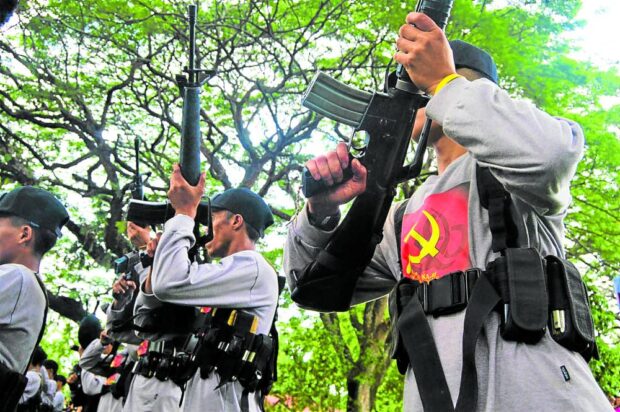
Inquirer File Photo
LUCENA CITY — The Communist Party of the Philippines (CPP) scoffed at the latest report by the Armed Forces of the Philippines (AFP) on the allegedly dwindling strength and numbers of the New People’s Army (NPA) rebels.
“The AFP keeps on saying that the NPA is diminishing, but they can’t wipe them out,” Marco Valbuena, CPP spokesman, said in an online interview Tuesday afternoon (Dec. 26).
He added, “They have a gunpowder mindset. The AFP thinks they can eliminate the NPA solely through their bombs and cannons, and by killing and intimidating the masses.”
Valbuena said the AFP has been making the same claims for years “they sound like a broken record.”
He was responding to claims made by Colonel Medel Aguilar, AFP spokesperson, in an earlier statement. Aguilar stated that Maoist rebels are now down to more or less 1,500 fighters.
Aguilar mentioned that the current strength of the NPA meant they could no longer generally stage tactical offensives or attacks against government forces.
He claimed that while the communist guerrillas “are still capable of mounting terror actions, we could see that generally, they could not conduct tactical offensives.”
Aguilar also dismissed the present role of the CPP Central Committee, alleging it “has no control,” is “weak and disorganized” and “no longer has leadership.”
“The CPP is not just one or a few people. As the CPP stated its task goes beyond the lifetime of any one person, and way beyond the capacity of a few people to perform,” Valbuena argued.
Meanwhile, Colonel Dennis Cana, public information officer of the military’s Southern Luzon Command (Solcom) based in Camp Nakar in Lucena City, reported the mass surrenders of NPA rebels have resulted in the decimation of Red fighters in Southern Luzon.
Cana noted that 64 former NPA combatants in the Southern Tagalog region and another 97 in the Bicol region have surrendered from January to November this year.
“There are still ongoing negotiations at present,” he said last week.
In the Bicol region, Cana reported one “weakened guerrilla front” and another platoon-sized remnant of a guerrilla unit remaining.
A weakened guerrilla front means it can no longer implement its programs like recruitment and generating resources for the armed struggle as opposed to active guerrilla fronts, according to the military.
In Southern Tagalog, Cana said there are remnants of platoon size NPA in the Quezon-Bicol boundary and platoon size each in Mindoro island, Batangas, and the Rizal-Bulacan boundary.
A platoon comprises fewer than 20 NPA combatants, according to Cana.
“The NPA now depends on the ‘people’s militia’ in their remaining areas of operation,” he said. The “people’s militia” is part of the insurgents’ mass base, which secures the NPA rebels while in the community. Sometimes, they are armed to reinforce the communist guerrillas during encounters.
The Marxist-Leninist-Maoist CPP was founded on Dec. 26, 1968, by writer and activist professor Jose Maria Sison as a breakaway group from the pro-Soviet Partido Komunista ng Pilipinas.
On March 29, 1969, the CPP formed the NPA in a village in Tarlac province, its first ragtag group of guerrillas armed with automatic rifles, single-shot rifles, and handguns.
Since then, the NPA has been waging the longest communist rebellion in the world.
Sison died of heart failure on Dec. 16, 2022, at age 83 in Utrecht, the Netherlands. He had lived in self-exile in Europe since peace talks with the government broke down in 1987.

